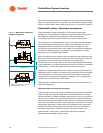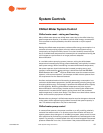
82 Chiller System Design and Control SYS-APM001-EN
System Issues and Challenges
Location of equipment
Location can be a major factor in contingency planning. When selecting the
location of the temporary equipment, it is important to consider:
• Water and electrical connections location
• Sound sensitive areas in the facility
• Location easily accessible to service staff
• Equipment separated from the public
Water and electrical connections
• Water connection size requirements
• External stub out locations
• Sufficient power to run the temporary unit
• Possible generator requirement
Ancillary equipment
• Pumping system requirements
• Temporary hose requirements
• Electrical cable requirements
This section briefly described some of the items to consider when
establishing a cooling contingency plan. There may be other considerations,
depending on the application. For information about failure recovery, see
page 95.
Alternative Energy Sources
Energy source redundancy is receiving increased attention due to rate
variations and reliability issues brought about by the deregulation of
electrical utilities across the country. There are two basic approaches to meet
these issues:
• Provide an alternate source of internally-generated electricity to serve a
system in the event of general failure or an unacceptably high temporary
cost of electricity (time-of-day or real-time rates).
• Provide an alternate source of chilled-water producing capability, possibly
fueled by natural gas, another fossil fuel, or even using low cost electricity
as an alternative energy source.
Electricity generation
The design, construction, and operation of full-capacity, electrical-generation
systems is well understood. The electrical-generation capacity can be sized to
allow an entire facility to operate or it can be sized for an emergency


















